GRACE Under Fire
Remote and beautiful, Antarctica is covered by an ice sheet averaging several kilometers in thickness that locks up some 70% of Earth’s fresh water—if it all melted, the oceans would rise about 70 m. Melting of the ice sheet is an obvious concern, since temperatures in the polar regions are increasing at about two-and-a-half times the average rate for Earth.
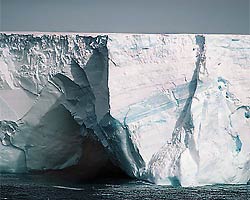
Mawson Ice Edge (photo by R. Williams, © Commonwealth of Australia)
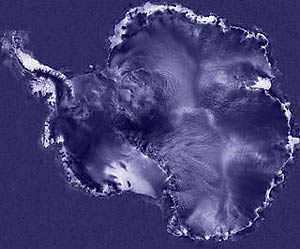
Map of Antarctica produced from radar reflections from the surface of the ice sheet; the Antarctic peninsula is in the upper left. (image credit: NASA/Goddard Space Flight Center Scientific Visualization Studio; Canadian Space Agency, RADARSAT International Inc.)
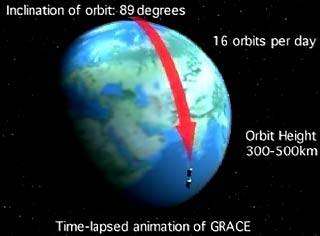
Grace’s polar orbit (image credit: NASA)
Nevertheless, as recently as 2004, substantial melting of the ice sheet had been dismissed because Antarctica is so cold. Except in the Antarctic Peninsula (which extends north in the direction of South America—see map), the average temperature on the continent is -7° C, and at no time in the year does the temperature rise above zero C, so no melting would occur. In the Antarctic Peninsula (see radar map), the average temperatures can reach -5°, and melting is possible during the two warmest months of the year.
Given these low temperatures, only the huge floating ice shelves that extend out from the coast would be threatened by ocean warming, since their undersides are in contact with ocean water. But melting of the shelves (see photo) would not raise sea level, because floating ice displaces its weight, which does not change upon melting. Still, the shelves are believed to play a role in preventing the movement of the rest of the ice sheet towards the ocean, and it is at the coast, where the underside of the shelves ride on ocean water, that a global temperature rise could produce increased melting.
The thickness of Antarctic ice has been measured by satellite-bourne radar. A pulsed radar beam is bounced off the ice, and the travel time from satellite to the surface and back is precisely measured. This method, though, has the disadvantage that the radar beam sweeps only a small area of land in each pass. Moreover, it is difficult to obtain results from regions where the height of the ice changes in the area swept by the radar, typically 15 km or more in diameter. The height of the ice sheet tends to be especially variable near the coast, where melting ice shelves have their largest impact.
A very different approach to measuring ice sheet thickness comes from the study of Earth’s gravity. If some of the sheet melts, the thickness of the sheet decreases and so does the acceleration of gravity over it, slightly changing the orbit of a satellite that passes overhead. A satellite in a circular orbit over a region of reduced mass would experience a decreased acceleration of gravity, increase its altitude (since the lower acceleration of gravity would not be sufficient to maintain the circular orbit) and slow down. Once clear of the area of lower gravity, the satellite would speed back up.
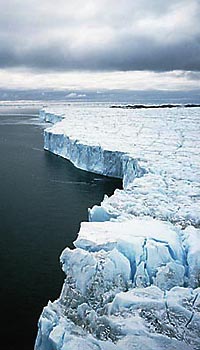
Antarctic ice shelf (photo by Robert Reeves, © Commonwealth of Australia)
This orbital effect is utilized in the Gravity Recovery and Climate Experiment (GRACE), a joint venture among NASA, the Jet Propulsion Lab (JPL), and the German space agency DLR. GRACE employs two identical satellites flying in formation in the same polar orbit (see drawing) at a separation of 219 km (137 mi). As the pair flies over Antarctica, the first satellite slows down, due to the melting of the ice sheet, so the separation between the two decreases. Later, when both have cleared the continent, the separation returns to its prior value. Since all Antarctic ice contributes to the gravity that the satellites experience, GRACE determines the thickness of the entire ice sheet, as opposed to the limited coverage of the radar studies.
Research
To precisely measure the separation between the two GRACE satellites, each one sends out a microwave signal, which the other detects, as shown in the drawing. On-board instrumentation measures the time of transmission and relative phase of the generated and received microwave signals. In addition, the global positioning system accurately specifies the satellites’ positions in three dimensions to within a few centimeters.
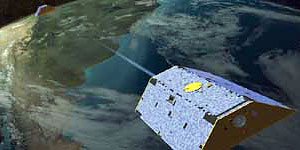
The two GRACE satellites flying in formation and communicating by a microwave beam, which is shown as a blue line; (image courtesy of NASA)
Since the measured change in gravity is so small, there are many corrections. The atmosphere beneath the satellites has mass and therefore exerts a small gravitational force. This effect can be modeled and accounted for using global air pressure data. Also, they are subject to non-gravitational forces, such as atmospheric drag, the pressure of sunlight, and even the pressure of reflected sunlight from Earth. Accelerometers on each satellite detect the effects of these forces, and a star-tracker determines the attitude of the spacecraft so that atmospheric drag can be determined.
When these data are combined, the separation of the pair of satellites can be specified to within a micron, about 1/50 the diameter of a human hair. Since the satellites fly in and out of sunlight, thermal expansion must be minimized, so their frames are constructed of plastic reinforced with carbon fiber.

Iceberg formed when a part of the ice shelf broke off. The shelves are believed to play a role in preventing the movement of the rest of the ice sheet towards the ocean. (photo by Robert Reeves © Commonwealth of Australia)
A big complication in the GRACE measurement of the Antarctic ice sheet thickness is the fact that the land beneath is lifting, part of the “post-glacial rebound” after the last Ice Age, which ended only about 10,000 years ago (melting in Antarctica continued up until only about 4,000 years ago). The crust—the uppermost layer of Earth—floats on the rock beneath, which is plastic and responds to changes in its “load” (see last link). The melting of the huge ice age glaciers removed a large mass from Antarctica, and the continent is slowly lifting to reestablish equilibrium. The GRACE scientific team used geological estimates of ice thickness changes and a model of rock flow beneath Earth’s surface to estimate the uplifting of the land, which is a significant effect.
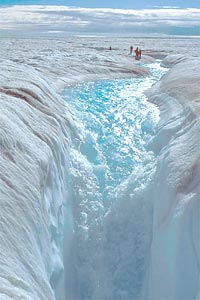
A meltstream in high summer on the Greenland ice sheet, (photo by Roger J. Braithwaite, The University of Manchester)
After taking into account all the above effects, the GRACE scientists find that from 2002 through 2005, the volume of the Antarctic ice sheet decreased substantially, corresponding to .4 mm plus or minus .2 mm of sea-level increase per year. This result was a surprise, both because of the extremely low temperatures in Antarctica, as mentioned above, and because forecasts of global warming had predicted increased snowfall in Antarctica.
In an earlier study, GRACE determined that the Greenland ice sheet is melting more rapidly than previously thought—in fact, the melting in Greenland and in Antarctica each produce about the same rate of sea level rise. So these ice sheets together add about .8 mm/yr. The overall rate of sea level rise over the last ten years, as obtained from statistical studies of radar measurements, is about 3 mm/year, and roughly half of this increase is due to thermal expansion of the oceans.
As the GRACE project continues, more data will accumulate and delineate the trend in ice sheet thickness over a longer time interval. Also, any change in the rate of melting would be unaffected by the correction for post-glacial rebound, which is presumed to be constant over long periods of time
Links
GRACE
Virtual Antarctica: Science
What is Isostasy?
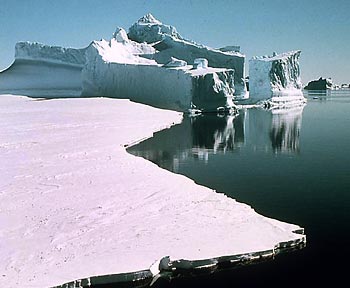
Mawson Ice Edge (photo by R. Williams, © Commonwealth of Australia)














